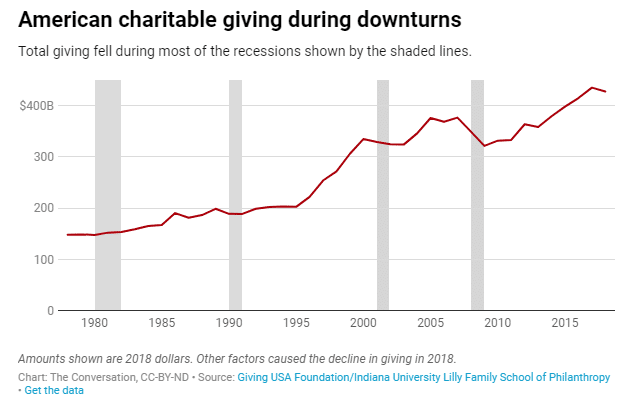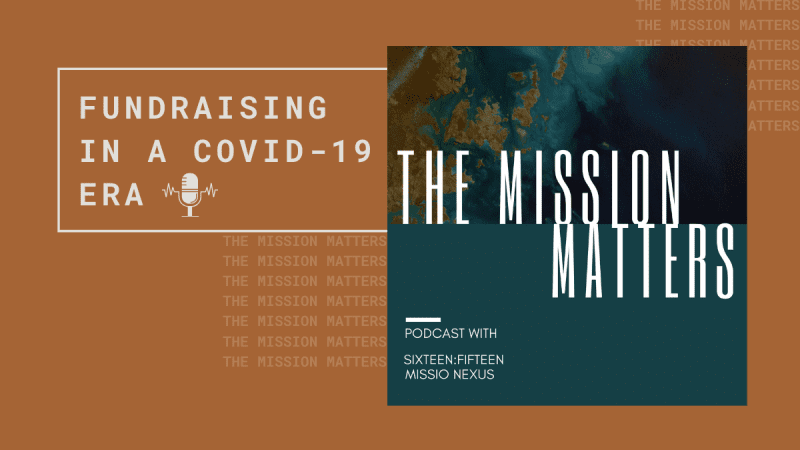Funding Fall Out from COVID-19

Fallout on Giving is Almost a Certainty
by Ted Esler, Missio Nexus President
According the research at Giving USA, annualized giving has gone up 3.3% per year, adjusted for inflation (Rooney & Bergdoll, 2020). While that sounds good, a more detailed look shows that within those aggregate numbers are some years where giving was down and others had explosive growth.

Note four downturns. In 1990 there was Gulf War 1. 2001-2002 was the bursting of the dot com tech bubble. In 2008-2009 the Great Recession happened. Way to the right you see the economic downturn that gave way to the Obama era stimulus package. The story is easy to see. Economic problems are fundraising problems.
Giving dropped by 7.2% in 2008 and then another 8% in 2009. That is a 15.2% drop in 24 months (more, if you do the math on a cumulative basis). Those organizations that were resilient (typically larger organizations) weathered the storm but smaller organizations were vulnerable. Those who depended on big, year-end fundraising success were probably hurt the most.
There are also unknown factors to consider in our fundraising future. In the US, leaders in Washington have hammered out a COVID-19 stimulus package. That might help. It might hurt. There is a legislative change to allow full deductions on charitable giving. The tax filing deadline has been extended and those who give part of their tax refunds will give later, if at all. On top of these unknowns it is an election year which pundits say has a negative effect on giving (Seaman & Young, 2018). The rapids are coming up and we should anticipate the rough waters ahead.
Hard and Soft Donations
There is a big difference between what we might consider hard and soft donations. A hard donation has the following attributes:
- Most importantly, hard donations are connected to a person or highly personalized cause.
- They tend to be regular donations, often made via automated processes, and have no stopping point.
- The person or cause is the story and there is little need to reframe the story.
Personal support raising donations are hard donations. When I raised personal support, I explained to potential donors that we would be working in Croatia and Bosnia. They would almost always confuse these places with regions in Russia. Yet they gave generously. They didn’t care about the location of our ministry. They cared about us. About my wife and the little kids that I was taking with me. I am not saying they did not care at all about the cause, but they trusted us and gave as a result. I have people giving to us today that started in 1989 even though our ministry has changed substantially. Those donations are hard donations.
A soft donation is markedly different in these ways:
- Soft donations support organizations or causes that are ambiguous. It might be for infrastructure, programming or other vital but relatively faceless needs. Buildings fall into this category as do IT projects. It could even be field-oriented projects that are not attached directly to a person, like Bible translation.
- Soft donations tend to follow campaigns and are one-time events. They follow an annual giving cycle and peak in year-end giving.
- Denominational or pooled giving funds are most often soft donations. A person doesn’t go to bed at night guilty because they did not write a check to your annual fund.
- A story must be constructed to gain the donor’s attention. I am not saying the story is false but the ambiguous must be made concrete. People want to know how their gift makes a difference and you must explain that to them.
Consider the changes that relief and development organizations have wrought on missions giving. We can observe that while there has been increased giving to international causes, almost all the increase has gone to relief and development. There are many reasons for this, but a key reason is that these organizations have learned to portray soft donations as hard donations. Instead of saying “Help us help the poor in Africa – we are raising 12 million dollars to feed people in need,” they created programs that connected people. Their appeal is more like this: “Give $30 per month to little Betsy so she can go to school, and here is a picture of little Betsy and she is going to write you a thank you note.” Of course, all those little donations might add up to 12 million dollars, but you would never know that. Another example is a donation to translate one Bible verse. This is an easier thing for people to give toward than “Bible translation” or even “This Bible Translation.” They can bite off a verse, but they aren’t so interested in eating an elephant, which is what a Bible translation project is.
Soft giving will be affected by an economic downturn much more than hard giving. When I worked in mission agency leadership, I was always amazed at the consistency of monthly supporters that gave to missionaries. Some of my supporters have given to us despite losing jobs or going into retirement. On the other hand, general fund giving, the ultimate soft donation, was more difficult in a downturn.
You may evaluate your income sources and determine which are most vulnerable to the hard/soft dynamic. We do not have hard numbers right now, but church budgets are extremely vulnerable. People not sitting in pews each week will have an impact on giving.
Another suggestion is (if your organization was around in 2008–2009) to go back to your historical data and chart it out like the graph above. How vulnerable was your funding during these past downturns? This can help you determine the mix of hard and soft donations and how much you might be affected going forward.
A Big Unknown: The Effects on DAFs and Foundation Giving
Donor Advised Funds (DAFs) are a huge part of the US giving system. Created to allow major donors to park their money in what is, more or less, a donor-controlled foundation, DAFs contains well over 1 billion dollars in assets just in the Christian sector. Most of this money is managed by a handful of very large institutions such as National Christian Foundation. In fact, it sits in managed brokerage accounts and thus has been hit heavily by the loss in value of the stock market. If you are a major donor and have a DAF you started getting emails a few weeks ago from the manager. They are exhorting you to be calm and not panic. That is not a good sign and does not create the sort of atmosphere in which donors open their hearts and checkbooks.
This highlights a philosophical issue behind DAFs. It is money that has only been given partially (this is done for tax reasons). The donor still controls the release of funds. Often, market conditions drive the extent of their generosity. Is it good stewardship to cut a check for 1 million dollars when that money has to be released by a stock sale? Most donors will seek to wait out the next few months in hopes that there is greater stability in the markets.
What should be done about this? Here are a few ideas to consider.
Scenario Planning
Create a scenario planning strategy that focuses on a worst, medium and best-case scenario. This plan should have “tripwire dates” when possible, which will force you decide or make a change to your plan. These are not predictions of the future, but suggest possible outcomes based on the best knowledge available right now. These plans are not static but should change as the situation changes.
Tighten up your communications strategy
Focus on solutions, not just problems. The bulk of your communication should be about how you are solving the short term, mid-term and long-term challenges. People need to know you are thinking and planning and not swept up in hysteria.
If you have never used video to communicate you are going to have to start. People want to hear from the leader in a time of crisis. You cannot delegate communication in a crisis. Now that we are doing everything virtually, we need to get better at video presentations.
You may need a “Third Party Reader” to your communications stream. Think of an old friend whom you trust but doesn’t live in your ministry world. Invite them to read what you are writing, tweeting, recording and otherwise communicating. I like to ask for feedback in most communication. A rule of thumb is that if one person writes with a complaint there are others with the same issue that do not take the time to do so. Make sure that people can send their praises and problems easily.
Keep in mind that authenticity is the currency of leadership during a crisis. Do not place protecting the organization in front of people. This does not mean that you drive yourself out of business for the sake of your employees. It does mean, for example, that if you can not pay salaries indefinitely, you will let people know sooner rather than later even if it hurts the organization by slowing down productivity. People are certainly our prime asset, after the Holy Spirit, and we need to make them our prime concern.
Understand the opportunities without being opportunistic
During the Great Recession, giving to homeless shelters and food pantries grew by 10%. There are organizations whose mission gives them a boost because they are meeting needs which we all know are intensified in a crisis.
The Vice President of Mobilization at Pioneers told me recently, “We have seen how when there is an economic downturn, more people are interested in going as missionaries. It might be that they lose a job and are asking what they want out of life, or that in times of crisis that they are reminded of what’s important in life, we are not sure all the factors. But we do think that the number of prospective missionaries might actually go up.”
Be careful what and how you communicate. Already, 2–3 organizations have sent mass email to me that makes me feel a little icky about what they are trying to do. Why? It feels like they are leveraging the situation for their own gain rather than responding to a difficult situation and want to genuinely serve others. Nobody likes exploitation; so be wary.
Now is the time to circle back to your major donors and let them know what you are experiencing. They do not expect you to have it figured out. They expect you to be figuring it out. Tell them what your process is for developing a response. They will appreciate knowing that more than getting a standard fundraising appeal which looks like you are on top of things. None of us know where this is going. Communicate process rather than a final solution. As I type this, it is simply too early to say with much certainty what the best course of long-term action will be for any organization.
This Too Shall Pass
There are some among us that will lose loved ones. Life will not be the same for those families. Some jobs will not come back. But history is not over. While we are now being subject to a great number of articles predicting the end of life as we know it, this will pass. It might even pass before the pundits think it might. Already, China shows signs of life returning to normal in places.
Go back to your main mission statement. Has COVID-19 changed it? I bet the mission you had a month ago is still valid. Even though there will be calls for massive rethinking about our organizations, the mission of the Great Commission has withstood worse situations. It will probably face worse situations in the future. The job of a leader is to think deeply about the mission and how it drives the organization. Most of you reading this have a team. Empower them to do things you have not considered them capable of before. Trust that they will get the job done. Listen more and talk less. Remember that strategy is driven by mission, not the other way around.
That last paragraph was true before COVID-19. It will be true well after. The mission is still the mission.
(updated on 4/1/2020 to correct date errors)
Rooney, P., & Bergdoll, J. (2020). What happens to charitable giving when the economy falters?
Seaman, B. A., & Young, D. R. (2018). Handbook of research on nonprofit economics and management: Second edition. Handbook of Research on Nonprofit Economics and Management: Second Edition. Edward Elgar Publishing Ltd. https://doi.org/10.4337/9781785363528



